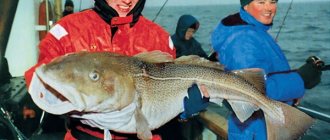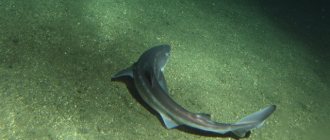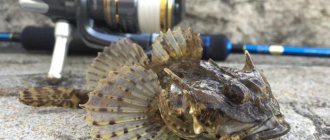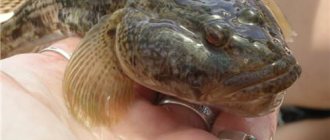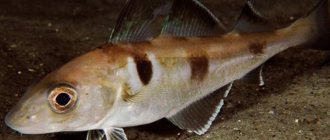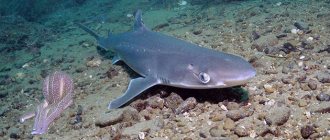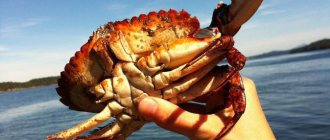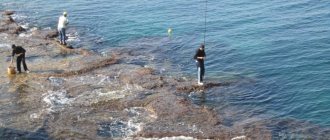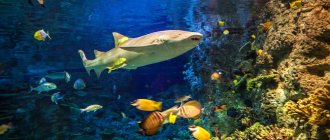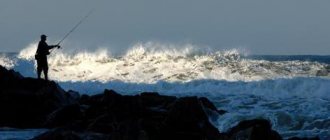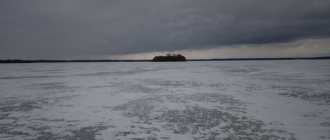Fishing on the White Sea
Only users with a rating above 20 can see the voting results (who voted and how).
Good afternoon. Finally, I decided to write a short report about our last fishing trip to the White Sea.
The road itself from the Tver region did not present any special surprises, but upon arrival we discovered that our intended departure point was covered with ice and launching boats was not possible.
A little upset, we began to look for a way out, which appeared before us in the form of UAZ cars in which local guys threw us with our things several tens of kilometers to clean water.
We collected the boats, went down to the still calm water and hit the road. Ahead of us lay almost 60 km of travel to an island with a familiar hut. The White Sea with floating ice floes greeted us with torrential rain and waves, but as they say, there was nowhere to retreat.
Rocks and frozen waterfalls floating by did not let our mood drop, and the words from the “Varyag” song heard over the water, performed by us, lifted our spirits and scared away curious seals.
I will not describe all our adventures in the next days, so as not to bore you. Several of them can be highlighted: the ice that came from the sea and cut us off from deep water for several days and an unsuccessful photo shoot, as a result of which our canon lies at a depth of 30m. It was this circumstance that influenced the quality and different sizes of the photos presented here.
A few words about gear and fishing methods. They fished mainly with jigs and jigs from boats and rocks. For the main “stick” I used a short Daiwa Team Daiwa MH spinning rod, a Ryobi Kriger 3000 reel and a 0.19 cord from Power pro. There was a greater variety of baits, which depended on the fishing location.
Fishing from the rocks seemed less convenient, but only until I decided to take foam with me.
The depth under these stones was small, about 15m. At first we tried fishing with a heavy jig, but there weren’t many bites.
Most of the bites occurred during the fall. Therefore, I decided to try small oscillating spoons. In the arsenal there was a small iron Evo-RG from Kosadaka in the size of 55m. Due to its shape, when falling, the spoon deviated from the trajectory and perhaps this provoked the cod to bite. I didn’t use leashes, for which I paid for it later.
I also tried a heavy kastmastet from the Acme company. The result was good, but again, due to the rapid fall of the bait, the bite became worse.
The Kosadaka MLx 55mm spinner also performed well from the rocks. But after a couple of fish, it was bitten off by some monster, I blame the catfish. In general, I noticed that the fish took spoons with a “edge” on the hook more willingly.
The cod pleased us not only with its bite, but also with its appearance. Depending on the fishing location, specimens of different colors were found. The color varied from dark green to pale yellow and even reddish. And of course, the ubiquitous “bulls” did not let us get bored.
A few words about the people and rules of the White Sea. On most islands there are houses with stoves and a supply of food that you can use if you get into trouble. But if you have the opportunity to update this stock, please do not skimp, maybe it will help someone. Still, mutual assistance in the “north” is not just words.
By the way, among the houses there are real masterpieces, but these are more than an exception to the rule.
Since it was the very beginning of the season, our only competitors were locals
Fishing from a boat is more effective. They are caught on a jig with shrimp or sand bait. Plumb or cast. Here the leader for me was the tires from Lucky John S-Shad Tail in the “machine oil” color and Kosadaka Xtech lure “Extreme edition” in the “Tr” color. The “Lucky John” rubber, apparently due to its similarity to sandblasters, was better, but it was enough for 5 or 6 bites, after which it turned into rags. Kosadaka's flavored rubber survived these tests without any problems.
Most of the small specimens were released, and we only took fish “for the pot.” In general terms, the bite was good and, if desired, it was possible to “fill in” quite a bit, but we were primarily interested in just relaxing
Fishing on the White Sea, cod. Kandalaksha Bay
Author on Youtube: Transfer Tour
Number of views per
Similar video
Download Fishing on the White Sea, cod. Kandalaksha Bay
Share this video
QR code with URL:
Link to page with video:
HTML link to the video page:
Player embed code:
Comments for this video:
Latest comments on the site
16 SCARY VIDEOS THAT WILL GET YOU FREAKED / TRY NOT TO BE SCARED ⇒ “I’ve always been interested in mysticism. Since childhood, the boys and I loved to tell each other scary stories in the evenings. When I first got the Internet, the first thing I did was start watching different horror stories. I was so fascinated by it that I... » Added - 11/20/2019 Who laid the bricks? Issue 487 (03/04/2019). Chapman Secrets. ⇒ “Thank you, Anna, the materials with your participation provide invaluable development of imagination, a completely different class than just fantasies or just technical projects. It seems that the coolest thoughts and discoveries are born at this level of consciousness. Volshe. "Added - November 20, 2019 I'm drawing a river ⇒ "cool. » Added - 11/20/2019 A herd of wild horses from Latvia / video: Rewilding Ukraine ⇒ “It’s so great to see animals in the wild! I always thought that horses literally personify the feeling of freedom and it’s a little sad to see them, for example, in the circus arena, etc. When you look at a herd of wild horses, your heart just rejoices for them, besides. "Added - 11/20/2019 Testing cheats on video ⇒ "I have never used cheats in multiplayer games, but at the same time I was curious to find out how they work and what the player sees when he uses them. It seems to me that the most harmless cheat in this video is wallhack, of course it gives a good advantage. » Added - 11/20/2019
Watch and download videos from YouTube in high quality.
Heading North! Cod fishing in the White Sea. Part 3
Early in the morning, Sasha came up to our tent and asked: “Guys, are you going to catch cod or relax. " Fatigue suddenly disappeared, Vadim and I jumped out of the tent and began to get ready to hunt cod in the sea. Frankly speaking, I had a hard time believing in the success of this event, because yesterday’s hunt for White Sea herring ended in complete defeat.
We started the engine and at low engine speeds we set off along the navigator track to the promising banks. According to Alexander, the cod hold on the raised granite ridges, which are often covered with dense thickets of kelp.
The first rafting over a promising place... Vadim gets a vague bite, the spinning rod immediately takes the shape of a parabola and his partner begins to pump out the caught trophy. The first trophy was a bull.
The gear for catching cod turned out to be exactly the same as for catching pike perch. I used my powerful Varita test range up to 45g, Shimano Ultegra 4000 reel, SunLine Super Braid 5 #1.5 diameter line, 28-35g jigheads and 3-4" vibrator tails. The bait in these conditions should imitate the usual target of cod hunting - White Sea herring. The most catchy rippers are considered to be white-blue, white-brown, that is, colors that, in our conditions, consistently shoot well at pike on the Desna River and its oxbow lakes. The bait is not completely attached to the jig head, only partially so that most of it hangs freely and is more mobile during the game.
The second approach is over the bank, the depth under the boat is about 6-7 meters and Vadim gets a bite again! The comrade begins to win the trophy. The water in the White Sea is as clear as a tear, so the entire path of the trophy, from the lowest point to the side of the boat, is easily visible. At first it seemed that the caught cod was unusually large, but... the closer the hooked fish came to the boat, the smaller it became in size. And so the first White Sea cod was brought on board. An unusually beautiful fish that sparkled in the rays of the rising sun with dark brown and burgundy tints. A start.
During our fishing trip we managed to catch some excellent fish. On one of the promising banks, only small cod weighing about 1 kg of dark brown color was caught. Bites in this place occurred with enviable regularity, but the farthest bank, the depth above which was about 7-8 meters, presented us with real trophies.
Soon luck smiled on me too. The next pass over the bank gave me a confident, powerful bite; after hooking, the fish moved from side to side and an enchanting dance began under water. Soon I managed to take my first cod on board! She was gorgeous and extraordinarily beautiful!
We decided not to experiment any more with fishing spots, but to focus on the bank, which brought really large fish. It’s noteworthy that vertical cod fishing somehow didn’t work out for me, so I caught it by casting on a pelagic jig. The bites are powerful, confident, exactly the same as those of a pike perch! This kind of fishing was very interesting and exciting.
The only problem when fishing for cod is getting caught on the powerful stalks of seaweed. During our fishing in these underwater thickets, we left a significant part of our fishing arsenal.
Local fishermen are armed with powerful Leningrad spinning rods with Neva reels and fishing line with a diameter of 0.6 -0.8 mm. With such equipment, you can easily pull out a kelp bush and lift it on board. When fresh, seaweed does not have a special taste; it gives off a lot of iodine.
The fishing somehow ended unexpectedly. Suddenly a strong side wind blew, multidirectional undercurrents formed in the sea and the bite instantly stopped. We go ashore and begin processing the caught trophies.
We only had a few hours left to stay in this place, so we wanted to try everything from the caught fish at once. Part of the team began preparing cod fish soup...
Vadim began to bake flounder and herring on the grill...
I wanted to try the legendary cod liver dish, but... we abandoned this idea. The whole liver was wormy, so we decided not to risk it, because there was plenty of food on the island.
The fresh fish dishes turned out to be very tasty, it was difficult to tear yourself away from the meal...
In the afternoon we jumped into the boats and headed for Solovetsky Island, towards civilization. It was a pity to say goodbye to such a wonderful place, but... no less interesting and exciting adventures await us.
Features of cod fishing in the White Sea
Cod fishing in the White Sea is a very exciting activity.
The cod of the subspecies GadllS morhua marisalbi lives in the White Sea; it differs from its Atlantic relative in its smaller size. Its length is generally 60 cm, but on average, specimens of more modest sizes are caught. Cod also varies seasonally. There is “summer” cod, which is smaller, and there is “winter” cod, which is larger in size.
Such winter cod approaches the coast at the end of August or beginning of September. The diet of cod includes smaller fish, primarily herring and sand lance, as well as bottom mollusks and various worms.
A large concentration of cod is noted in the Kandalaksha Bay (this is where the most productive cod fishing in the White Sea), but in shallow bays such as Onega and Dvina, cod is rare.
In summer and early autumn, cod are mainly found close to the shore. To get large specimens, you should look for them near rocks that go vertically into the sea, where there are sharp drops in the depths. Small cod are best caught off the rocky shore in shallow waters.
You should know that cod does not like silted and heavily foamed bays, as well as sandy beaches. As for the open sea, cod there prefers to be near rock ridges, which are covered by sea bottom vegetation. Such banks, as a rule, rise above the rest of the bottom topography. On the Coast of North Karelia, such places are called baklyshi or corgi.
In appearance, such areas look like a boulder that rises several meters above the water. It has no vegetation, and the depths there can reach 30 meters or more with fairly sharp drops.
Where the drop is steepest, cod fishing will usually be most effective. Cod also chooses places for parking where there are various rocky formations in places where coastal cliffs continue or in underwater crevices.
Such places are easily identified visually if you carefully study the coastline. This is, as a rule, a sheer rock, which is cut through by a crack and continues under water with a depth of 15-25 meters.
Of course, cod can also be found at much greater depths. Cod also loves the straits between the islands, where there is a fairly strong tidal current.
At the beginning of May, cod fishing begins, which often comes close to the shores when the sea opens up from ice. But soon, in the bays that cut deep into the land, cod bite for a long time. This is probably due to the fact that in such places the water is desalinated from melting ice for a long time.
Then the cod bite becomes active in early June and lasts almost until mid-October. In summer, there are also pauses in the bite, which are associated with the rise of cold water from the bottom of the sea.
Along with this rise, the migration of food organisms occurs. Shrimp, mollusks and others follow, followed by cod.
Also, cod during the mating of sea worms (nenreis), at this time cod fishing in the White Sea is carried out not with bottom gear, but with wire gear.
Local residents catch cod from boats using fairly simple gear consisting of thick fishing line with a diameter of 0.5-0.7 mm, reeling it on a reel. The role of the load is played by a fairly heavy spoon or a tube with a hook, white or made of brass.
The weight of such spinners is about 60-70 g. It is also possible to simply use a regular lead weight. In addition, tackle with a spinner may have leashes with a single hook.
In the Loaded Option, such leashes are mandatory. Fishing with such equipment is called “finger fishing”.
A cod bite is felt by the hand as a “blow”. Typically, anglers use a sandworm worm as a bait, which they extract with shovels at low tide. Since sea worms cannot survive for long outside their habitat, it is recommended before each fishing trip.
Alternatively, Nereis can be used to catch cod. When the breeding season of this worm begins, it comes to the surface of the water and is quite easy to catch.
And here's what you need to know: Dough for fishing Recipe for how to prepare dough for catching peaceful fish crucian carp
Metal cats are used to pull out seaweed bushes from the water, in the roots of which they collect the Nereis sea worm. In addition, fishing for cod in the White Sea can also be done using bait such as pieces of capelin, herring, and chicken.
However, they cannot be compared with the first two baits in terms of effectiveness.
Cod fishing on the White Sea
Fishing on the White Sea differs from fishing in other seas or reservoirs, this is due to climatic conditions.
The main features of fishing on the White Sea:
- Cold water, even in summer.
- The maximum water surface temperature in the hottest month does not exceed 18 degrees Celsius.
- Complex bottom topography, as well as highly pronounced ebbs and flows.
- Frequent changes in wind direction.
- Mostly cold gusts of wind are observed, often stormy.
- The average wave height is 2-3 meters.
- The need to use several types of bait, including artificial ones.
- The probability of catching a large cod is minimal.
- The weight of such an individual varies from 750 to 950 grams.
- Possibility of successful biting around the clock and even in bad weather conditions.
For an untrained fisherman, fishing is quite difficult the first few times, so it is better to take an experienced person with you.
Northern exotica – fishing in the White Sea
> Where to fish > Fishing in Russia and around the world > Northern exotic – fishing in the White Sea
Fishing on the White Sea is,
to some extent, an exotic and extreme thing. This is due to its climatic and geographical features. The area of the White Sea is 90,000 km². The greatest depths do not exceed 400 meters. Sea tides have a significant impact on fishing.
Not all bays have the same salinity; the Dvina, Mezen and Onega bays are less saline and there is practically no sea fishing there due to the large influx of fresh water. But excellent sea fishing on the White
Sea
is carried out in the Kandalaksha Bay on the coast of the Terek and Karelian isthmuses. Only fish species that permanently live in the sea enter these places.
Among fishing enthusiasts in the White Sea, species such as salmon, catfish, whitefish, cod, herring, navaga, and flounder are especially popular. Other fish are considered less important and will mainly be caught as catch.
Catfish
The best place for catching catfish is Kandalaksha Bay. One of the subspecies of Atlantic catfish lives here, the size of which can reach 85 cm. Catfish for fishermen as a trophy is not inferior in value to cod. This fish has delicious, tender meat, and in July you can even enjoy its caviar, which is not inferior in taste to salmon.
The catfish's diet is quite varied, it includes mollusks, starfish, crabs, sea urchins, shrimp, and also feeds on small fish. This fish has excellently developed conical and chewing teeth, which easily grind and crush the fairly strong skeletons of various mollusks, echinoderms and crustaceans. They catch catfish using bottom gear starting in May, at which time catfish can even be seen at shallow depths in coastal waters not far from the shore. As for the rest of the time, it goes into the depths, where it is more difficult to catch it. To catch catfish, only steel and Kevlar leashes are used; the rest can easily be ground with its teeth.
Cod
Cod in the White Sea differs from ordinary Atlantic cod in its size; as a rule, it is one and a half to two times smaller. Usually its length is no more than 60 cm. But even such specimens do not often pamper the fisherman. The largest individuals are found in the deepest Bay of the White Sea, Kandalaksha Bay. Fishing in the White Sea
for the largest cod, it is usually fished near sheer rocks that go into the depths; small cod is excellently caught in shallow water and in places where there are a lot of stones at the bottom.
Navaga
This small fish is also one of the representatives of the cod family. Usually the length of navaga does not exceed 40 cm. Today it is the main commercial species of the White Sea. The main habitat of navaga is the Onega, Dvina and Mezen bays. As for Kandalaksha, it is rare there.
Whitefish
Whitefish is one of the most respected trophies for fishermen on the White Sea. Whitefish mainly live in coastal waters in straits, numerous shallows and bays. The diet of whitefish includes a variety of bottom organisms, amphipods, mussels, worms and other bottom living creatures. Adult whitefish spawn 3 times in their lives. As a rule, whitefish are caught using nets, and amateurs catch them with a spinning rod. Whitefish are often caught as bycatch during the harvest of herring, smelt and other fish. Whitefish is famous for its valuable dietary meat with excellent taste. This fish is delicious in any form.
Herring
Herring is one of the main species that is commercially fished in the White Sea. The most interesting thing is that despite its proximity to the Atlantic Ocean of the White Sea, it is not Atlantic herring that lives there, but Pacific herring. As a rule, they are caught with trawls or nets, and many local fishermen catch herring with floating nets. In summer, this fish accumulates in large quantities in Chupinskaya Bay and feeds very actively and is caught in large quantities. In the fall, having accumulated a sufficient amount of fat, the herring accumulates in deep bottom holes, where it overwinters. In autumn, herring is caught in large quantities, and it is the most caught fish in the White Sea.
Flounder
As for flounder, there are 5 species of this fish in the White Sea. Of these, 3 species are river flounder. Polar and ruff are permanent inhabitants of the White Sea, they can be found in any part of it. Two species, sea flounder and ruffed flounder, migrate to the White Sea from the Barents Sea in summer to feed. Fishing for flounder in the White Sea
usually carried out with a float rod or a tyrant. Usually the bait for catching flounder is a sea worm, of which you can find a lot on the sandbanks after low tide.
Fishing is very popular on the Karelian coast of the White Sea. This is a very beautiful and picturesque place, abundant in fish resources. The most desirable catch for anglers in these places is sea and lake salmon, which can be caught throughout the warm season using a spinning rod or fly rod.
Pink salmon can be caught well from the second half of July to the first half of August, at the mouths of rivers flowing into the White Sea. The length of some individuals can reach more than 70 cm and weight about 6 kg.
Pink salmon caviar is very tasty, like any salmon. Pink salmon are usually caught near the shore in shallow water or shallow depths. In these same places you can successfully catch capelin, smelt, eelpout, goby and sometimes sea bass. Also, in the mouths of rivers flowing into the sea, you can successfully catch freshwater fish species, bream, silver bream, rudd, even large pike.
Sport fishing for such a strong predator as a shark is of great interest to amateur fishermen; they are caught using strong, reliable gear, using fish fillets or seal meat as bait. Sharks are especially good at catching seal oil.
To summarize briefly, sea fishing on the White Sea
, interesting, diverse, and always pleases anglers with excellent catches.
Published: 08/07/2014
Other interesting materials:
| Fishing in Chukotka - Russian extreme! The main part of the Chukotka Autonomous Okrug is located beyond the Polar... | Sakhalin. Sports fishing for adventurous travelers The Sakhalin region is a unique place in Russia. This area… | Catching predatory fish in Belgium Catching predatory fish, especially with spinning baits, is very... | Fishing for grayling by boat Grayling fishing is popular in many parts of our country, where... |
Where to look for cod in the White Sea?
Due to the relief features of the White Sea, as well as its depth differences, the distribution of cod in different areas is not the same.
You need to look for such fish depending on several factors:
- Season: in winter and until the end of spring - mainly at depth or in straits, and also where there is movement of warm currents.
- all summer and early September - it is better to look for nearby coasts;
- closer to mid-autumn and before the beginning of winter - mainly near rocks or in crevices.
- if fishing is done from the shore, then you need to choose places near the rocks;
- depths from 5 to 10 meters are most successful for fishing in the warm season;
Interesting fact: June and July are the months in which the greatest bite is observed, but the fish caught are on average about 30 centimeters long.
Among experienced fishermen, it is believed that the most successful place is an area rising 2-3 meters above the sea surface.
When to catch cod on the White Sea?
On the White Sea, cod fishing is guaranteed in any season, each has key features and distinctive points:
- Fishing in winter and spring: the possibility of biting the heaviest individuals;
- most often you come across a fish of about 900 grams, this is considered large in size for the White Sea;
- maximum predominance of cod at depth or in underwater crevices;
- It bites best on a combination of organic and artificial baits.
- cod is small in size, approximately 40 centimeters and weighing 700-800 grams;
Knowledgeable fishermen claim that on the White Sea the most fruitful periods for biting are as follows:
- from late April to mid-May - especially near the coast;
- from the first days of June to mid-October - at a distance of 150-200 meters from the shore.
Interesting fact: the bite is lowest during the period when there is a rise in cold waters from the depths, so it is advisable to refuse fishing on these days.
Go fishing on the White Sea. Fishing places
The White Sea, being a vast bay of the Arctic Ocean, is quite cold. Nevertheless, the skerries and sea expanses, as well as the amazing taiga nature, attract many. People come here for privacy from the hustle and bustle of cities. Relaxation, fishing on the White Sea, fish soup cooked over a fire right on the shore - what could be better for relaxing and gaining strength.
Fishing from a boat or from the shore?
Fishing can be done quite successfully both from the shore and from a boat. Basically, experienced fishermen prefer to fish on motor boats; this makes it possible, in case of low bite in one area, to move to another area.
On the White Sea, fishing from boats has some characteristic features:
- it is necessary to move away from the shore by more than 200 meters, this allows you to not depend on the tides;
- it is required to use fishing lines exclusively with a diameter of 0.5-0.7 millimeters;
- you need to give preference to fishing gear and choose hooks made of brass;
- with the arrival of cold weather, be sure to move closer to the stone ridges, and in warm weather, choose an area near the rocks;
- move to a depth of at least 10-12 meters and where there is a strong current.
Many fishermen note that fishing for cod from the shore will bring more expected results, especially from the end of May to mid-August, the main thing is:
- fish during high tide;
- change bait as often as possible;
- cast with several fishing rods, preferably long in size;
- be located next to rocks;
- choose the time for fishing from 6-7 am until noon.
Wild holiday
When planning a fishing trip on the White Sea, a savage should carefully prepare. Approximate list of equipment:
- navigator;
- tent;
- sleeping bag;
- anti-mosquito products;
- knife;
- fishing tackle: different types of bits, fishing lines, spoons;
- various baits;
- compass;
- matches;
- first aid kit with medicines and medical products;
- warm waterproof clothing;
- Food;
- kettle, thermos.
Tackle for cod fishing on the White Sea
Successful fishing directly depends on correctly selected gear. In general, it is possible to fish with various options of float rods, spinning rods and other things.
When choosing gear, there are several points to consider:
- Buy a medium-sized rod , but very durable, which can withstand many casts.
- The ideal length of a spinning rod for cod is from 1.8 to 2 meters.
- The weight of the tackle should be heavy , otherwise there will be difficulties when pulling out cod.
- It is better to take a multiplier reel designed for sea fishing, otherwise after the first contact with water it will rust and will be unsuitable for further use.
- In the summer, it is more advisable to abandon bottom tackle in favor of a short spinning rod or feeder.
- When fishing with a spinning rod, you need to have a large amount of different bait with you, since with this type of gear there is a risk of losing or breaking the bait.
- Use the equipment as simple as possible , a fairly reliable fishing line and hook.
In the White Sea it will not be possible to catch a trophy specimen, even if you use the latest and improved gear
The daily diet of cod consists of small fish or shellfish, so when choosing a bait option, you must take this factor into account.
It bites well on many natural baits, especially:
- medium and large sized sea worms;
- pieces of herring;
- capelin;
- small sea bass;
- shrimp;
- shellfish
Advice: the main thing is that any bait is fresh, so you should look for it before you start fishing.
It is allowed to fish with artificial baits, sometimes the bite on them is not inferior to most natural ones, but you should only choose bright and shiny colors, preferably with many threads.
You can make spinners yourself - for them it is better to use red or white colors and a tee No. 12-14.
How to catch more fish?
Fishing tactics
For a fruitful bite, it is important to maintain a clear sequence in fishing, otherwise, even the presence of a large number of individuals in the sea will not bring the planned result.
Fishing tactics include several stages:
- Throwing the tackle to the maximum possible distance, the most optimal is considered to be from 14 to 25 meters.
- It is better to cast in several places at once, especially when fishing from the shore.
- Pulling donkeys, spinning rods and other things a short distance towards the boat or shore.
- Lowering the bait to the very bottom, then making 5-6 light but quick strikes to attract fish.
- Raising the bait approximately 40-50 centimeters from the bottom surface.
- If the bait is left on the bottom, the cod may not notice it.
- Periodically perform gentle twitching of the tackle, optimally at intervals of 10-15 minutes.
- Confident fishing immediately after the bite and further sharp hooking.
Interesting fact: the cod bite is sudden, so any relaxation during fishing will lead to the fish breaking off.
It is easier to carry out hooking together, in this case the chance of not missing the prey is much higher. In any case, even in the absence of bites, it is necessary to constantly monitor the presence of bait. Cod has a unique ability to unnoticed by the fisherman to pull any bait off the hook.
Advice: it is better to check the presence of bait every 30-40 minutes.
Blitz tips:
- any equipment used must be durable; select equipment only suitable for fishing in salt water;
- It is more advisable to first catch a small sea bass or capelin and then use them as bait;
- if there is no bite, try casting with artificial bait;
- when hooking fish, any relaxation should be excluded;
- in winter it is better to use shellfish or worms as bait;
- Be sure to take warm clothes with you due to the unpredictability of the weather.
